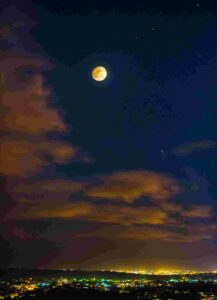The moon, ever-present yet elusive, has captivated humanity for millennia. Floating quietly in the night sky, it is more than just a celestial body; it is a silent poet, weaving tales of mystery, romance, and reflection through its phases. As it waxes and wanes, the moon reflects the rhythm of life itself, reminding us of nature’s cycles, the passing of time, and the beauty in change.

A Timeless Symbol of Mystery and Inspiration
For centuries, poets, artists, and dreamers have turned to the moon for inspiration. Its ethereal glow illuminates the night, casting a soft light on the world, while simultaneously stirring something deep within us. From ancient mythologies to modern art, the moon has been a muse, symbolizing everything from femininity and fertility to solitude and introspection.
In Greek mythology, the moon was personified as Selene, a goddess who rode across the night sky in a chariot, her beauty lighting the way. For the Romans, Luna represented the same mystique. Even today, the moon remains an emblem of mystery, influencing our art, literature, and even our emotions.
The Phases: A Poetic Rhythm
One of the most striking features of the moon is its cyclical phases. From the full moon’s luminous presence to the barely visible new moon, these changes have always been seen as symbolic. They represent growth, decline, renewal, and the constant motion of life itself.
- New Moon: A time of beginnings, the new moon represents a fresh start, a blank slate in the sky.
- Waxing Crescent: As the moon grows, so too does the potential for growth in our own lives. It’s a time of gathering strength.
- Full Moon: The full moon symbolizes completion and fulfillment. Its bright light brings clarity and amplifies emotions.
- Waning Moon: As the moon begins to shrink, it signals a time of reflection, release, and letting go of what no longer serves us.
Just as poets craft their verses with intention, the moon’s phases guide us through our personal journeys, each phase offering its own lesson in patience, growth, and acceptance.
The Moon’s Influence on Nature and Culture
The moon’s pull extends far beyond poetic symbolism. Its gravitational force affects ocean tides, guiding the rhythm of the seas. This celestial connection to water has been linked to human emotions, particularly the ebb and flow of moods, which is why we often associate the moon with feelings of reflection and introspection.
Culturally, the moon plays a significant role in various traditions and beliefs. In many ancient civilizations, lunar calendars dictated the agricultural cycle, while in astrology, the moon represents emotions, intuition, and our inner world. Even today, festivals like the Mid-Autumn Festival and Ramadan are based on the lunar calendar, illustrating how this silent poet still influences human lives in profound ways.
A Source of Solace and Connection
Gazing at the moon can offer a sense of peace and connection. In a world that is constantly in motion, the moon remains a steady, quiet presence. Its glow links people across time and space. Whether you’re standing on a crowded city street or in the middle of a remote desert, the moon’s light is the same, offering solace in its constancy.
For many, the moon serves as a reminder that, even in moments of solitude, we are never truly alone. Its light reaches everyone, creating a shared experience that transcends borders and generations.
The Future of the Moon: Exploration and Beyond
As science advances, humanity’s relationship with the moon evolves. No longer just an object of wonder, the moon has become the focus of space exploration. NASA’s Artemis program aims to return humans to the lunar surface, unlocking new possibilities for research and potential habitation. Yet, despite these technological advances, the moon will always retain its poetic allure. Even as we venture further into its mysteries, its silent presence in the night sky will continue to inspire awe and reflection.
Conclusion
The moon, with its phases, myths, and undeniable beauty, stands as a silent poet in the night sky. It speaks to the depths of human emotion, reminding us of the cyclical nature of life, the power of change, and the quiet strength found in solitude. Whether seen through the eyes of a scientist, a poet, or a dreamer, the moon will always hold its place as a source of wonder, inspiration, and connection.
So next time you find yourself under its glow, take a moment to pause and listen. The moon may be silent, but its poetry speaks volumes.




